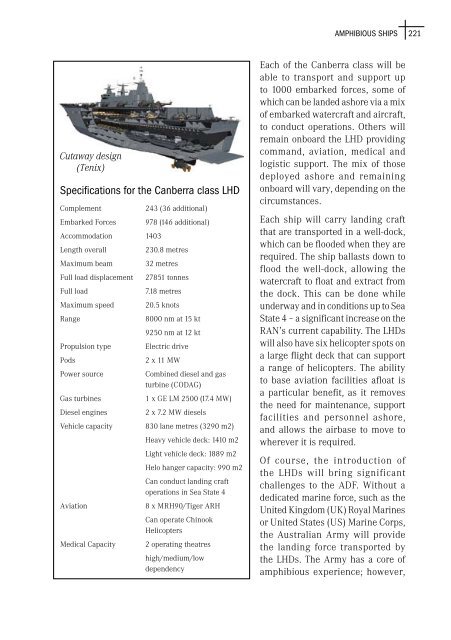Australian Maritime Issues 2007 - Royal Australian Navy
Australian Maritime Issues 2007 - Royal Australian Navy
Australian Maritime Issues 2007 - Royal Australian Navy
Create successful ePaper yourself
Turn your PDF publications into a flip-book with our unique Google optimized e-Paper software.
AMPHIBIOUS SHIPs<br />
221<br />
Cutaway design<br />
(Tenix)<br />
Specifications for the Canberra class LHD<br />
Complement<br />
243 (36 additional)<br />
Embarked Forces 978 (146 additional)<br />
Accommodation 1403<br />
Length overall<br />
230.8 metres<br />
Maximum beam 32 metres<br />
Full load displacement 27851 tonnes<br />
Full load<br />
7.18 metres<br />
Maximum speed 20.5 knots<br />
Range<br />
8000 nm at 15 kt<br />
9250 nm at 12 kt<br />
Propulsion type Electric drive<br />
Pods<br />
2 x 11 MW<br />
Power source<br />
Combined diesel and gas<br />
turbine (CODAG)<br />
Gas turbines<br />
1 x GE LM 2500 (17.4 MW)<br />
Diesel engines 2 x 7.2 MW diesels<br />
Vehicle capacity 830 lane metres (3290 m2)<br />
Heavy vehicle deck: 1410 m2<br />
Light vehicle deck: 1889 m2<br />
Helo hanger capacity: 990 m2<br />
Can conduct landing craft<br />
operations in Sea State 4<br />
Aviation<br />
8 x MRH90/Tiger ARH<br />
Can operate Chinook<br />
Helicopters<br />
Medical Capacity 2 operating theatres<br />
high/medium/low<br />
dependency<br />
Each of the Canberra class will be<br />
able to transport and support up<br />
to 1000 embarked forces, some of<br />
which can be landed ashore via a mix<br />
of embarked watercraft and aircraft,<br />
to conduct operations. Others will<br />
remain onboard the LHD providing<br />
command, aviation, medical and<br />
logistic support. The mix of those<br />
deployed ashore and remaining<br />
onboard will vary, depending on the<br />
circumstances.<br />
Each ship will carry landing craft<br />
that are transported in a well-dock,<br />
which can be flooded when they are<br />
required. The ship ballasts down to<br />
flood the well-dock, allowing the<br />
watercraft to float and extract from<br />
the dock. This can be done while<br />
underway and in conditions up to Sea<br />
State 4 – a significant increase on the<br />
RAN’s current capability. The LHDs<br />
will also have six helicopter spots on<br />
a large flight deck that can support<br />
a range of helicopters. The ability<br />
to base aviation facilities afloat is<br />
a particular benefit, as it removes<br />
the need for maintenance, support<br />
facilities and personnel ashore,<br />
and allows the airbase to move to<br />
wherever it is required.<br />
Of course, the introduction of<br />
the LHDs will bring significant<br />
challenges to the ADF. Without a<br />
dedicated marine force, such as the<br />
United Kingdom (UK) <strong>Royal</strong> Marines<br />
or United States (US) Marine Corps,<br />
the <strong>Australian</strong> Army will provide<br />
the landing force transported by<br />
the LHDs. The Army has a core of<br />
amphibious experience; however,
















